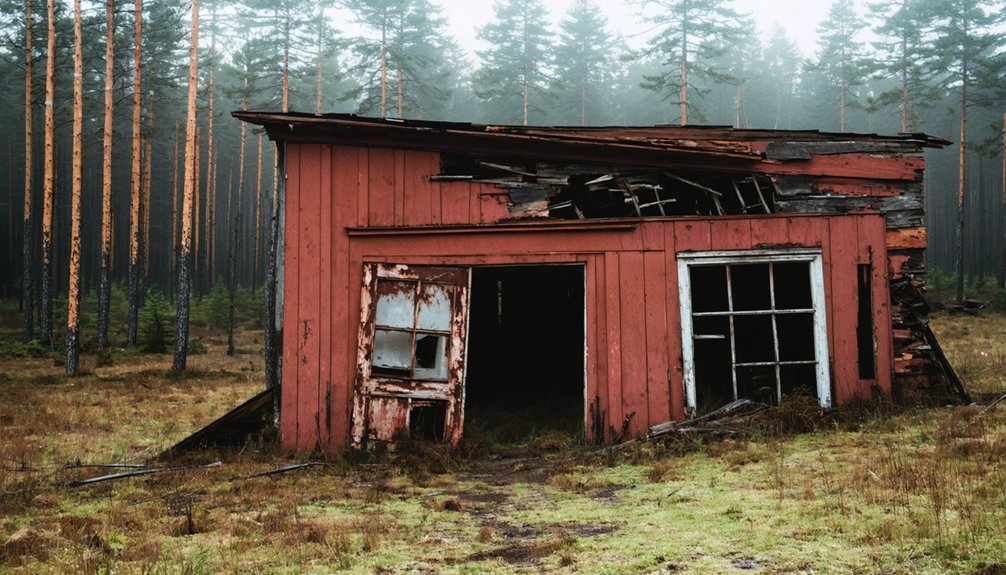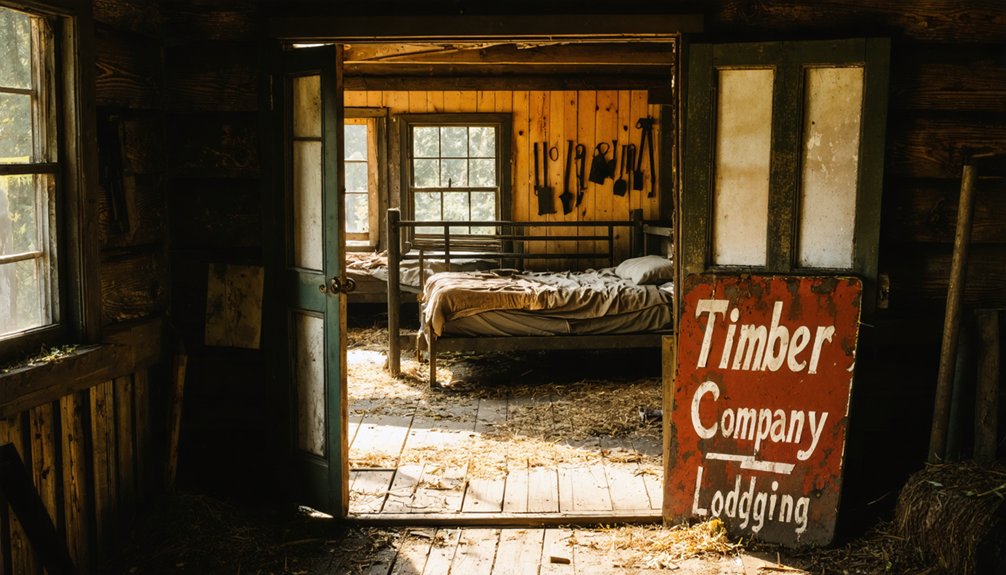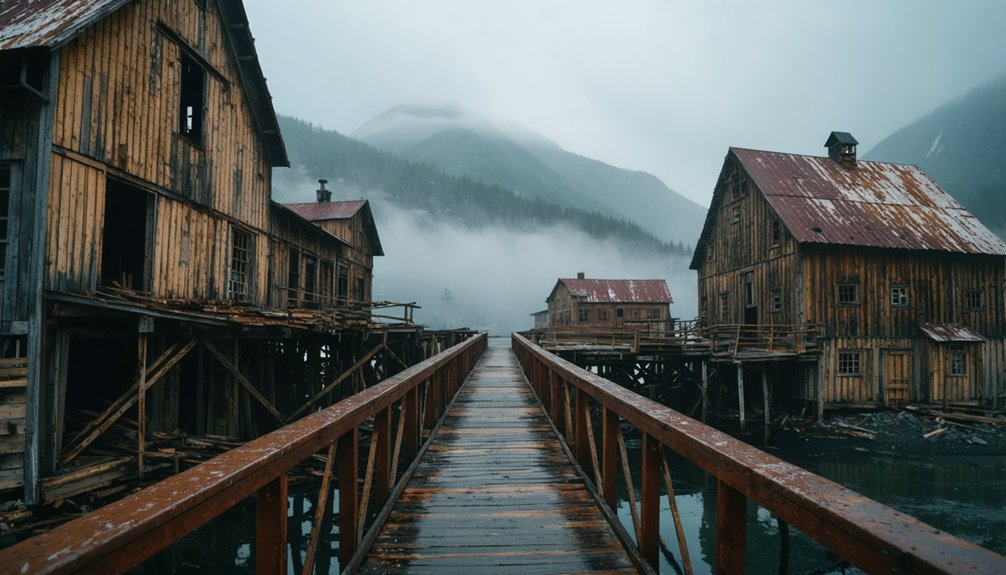When you explore America’s abandoned logging towns, you’ll witness the timber industry’s legacy from Maine to Oregon. These ghost towns flourished between 1800-1950 before being deserted when forests depleted. You’ll find preserved mill structures, worker housing, and rusting equipment that reveal harsh working conditions and rigid social hierarchies. Sites like Elkmont, Tennessee and Eagle Creek, Oregon offer unique insights into resource-extraction history and environmental impacts that shaped today’s landscapes.
Key Takeaways
- Abandoned logging towns like Elkmont and Eagle Creek preserve America’s timber industry heritage through historic buildings and infrastructure remnants.
- These towns showcase the boom-and-bust cycles of logging communities, which often disappeared after old-growth forests were depleted.
- Architectural features reveal social hierarchies and living conditions, from ornate manager homes to simple worker bunkhouses.
- Environmental impacts remain visible, with clear-cutting consequences contrasting against nature’s reclamation of abandoned areas.
- Heritage tourism opportunities include guided tours, museums in former logging facilities, and festivals celebrating timber industry cultural heritage.
The Rise and Fall of America’s Timber Boomtowns

When you trace the evolution of America’s timber industry, you’ll find its origins firmly planted in colonial soil, where the nascent lumber trade began in 1607 as Jamestown settlers harvested timber for both local construction and profitable export to Britain.
The industry’s trajectory followed America’s westward expansion, with production centers shifting from New England to the Great Lakes and eventually the Pacific Northwest. As forests in the Midwest diminished, industrious loggers relocated to the resource-rich Great Lakes region by 1880. By 1970, the Pacific Northwest states of Washington and Oregon had become the dominant timber producers, accounting for 41% of production nationwide.
As America pushed westward, so too did its timber industry, migrating from New England’s forests to Pacific Northwest timberlands.
You’d recognize these patterns in Idaho’s dramatic growth from 65 million board feet in 1899 to 745 million by 1910. Boomtowns flourished wherever timber stood tall, creating instant communities with mills, housing, and commerce.
Yet these settlements lived and died by economic fluctuations, resource availability, and market demands. Once old-growth forests vanished, towns often followed—victims of their own success and the timber industry’s relentless appetite.
Ghost Towns of the Great Forests: Notable Examples Across States
Across America’s forested regions, abandoned logging settlements stand as haunting reminders to the timber industry’s boom-and-bust cycle.
Elkmont history exemplifies this pattern—a once-thriving Tennessee community within Great Smoky Mountains National Park, now preserved with over 60 historic buildings.
Similarly, Oregon’s Eagle Creek remnants mark where hundreds once worked along Columbia River Gorge, though little remains beyond interpretive signs and old rail lines.
Pennsylvania offers contrasting examples: Ricketts Glen State Park contains subtle traces of logging infrastructure now reclaimed by nature, while Centralia’s abandonment was accelerated by an underground coal fire that continues burning today. Like Saint Elmo, these towns preserve a fascinating glimpse into America’s industrial past.
Mill City, Oregon represents partial recovery, maintaining its heritage through the Mill City Museum despite devastating floods that hastened its decline in the mid-20th century. In North Carolina, Mortimer was established to house workers by Ritter Lumber Company in the early 1900s before being gradually abandoned due to devastating floods and fires.
Clear-Cutting and Consequences: Environmental Legacy of Logging Towns

The environmental legacy of logging towns extends far beyond their abandoned structures, manifesting in profound ecological changes that persist for generations. As you explore these forgotten settlements, you’re witnessing the aftermath of clear cutting impacts that fundamentally altered entire ecosystems.
The aggressive deforestation practices released cascading environmental degradation: severe soil erosion where tree roots once stabilized hillsides, disrupted water cycles affecting local precipitation patterns, and released billions of tonnes of stored carbon into the atmosphere. While some logging operations left reserve trees for wildlife shelter, most historical clear-cuts removed all vegetation, maximizing short-term profits at the expense of ecosystem health. Many replanted areas lack the rich biodiversity and resilience of original forests, making them more vulnerable to disease and climate change effects.
What you’re seeing isn’t just economic abandonment but ecological transformation. Waterways still carry the sediment burden from increased runoff, while biodiversity struggles to recover in fragmented habitats.
These ghost towns tell a complex story of human industry colliding with natural systems, creating environmental consequences that continue to reshape landscapes long after the last logger departed.
Life in the Sawmill Communities: Social Dynamics and Daily Existence
Life in sawmill communities reflected rigid social hierarchies that permeated every aspect of daily existence. As you explore these abandoned sites, you’ll notice the physical manifestations of class division—from ornate manager homes to basic worker bunkhouses.
Community bonds formed within racial and ethnic clusters, creating solidarity despite company-imposed divisions. These towns were established out of necessity as logging operations moved into remote areas, fostering stable workforces and community feelings. Workers often endured grueling 10-hour days performing physically demanding tasks in the forest before returning to their company-provided housing.
- Your survival depended on company scrip usable only at the company store.
- You’d likely grow gardens and raise chickens to supplement meager provisions.
- Your home would lack indoor plumbing until the late 1920s in most towns.
- You couldn’t protest working conditions without risking immediate eviction.
- Your entertainment options were company-controlled activities designed to build workforce loyalty.
This controlled environment created resilient communities where workers forged strong social connections despite the oppressive economic structure that governed their lives.
Preserving America’s Logging Heritage: From Ruins to Tourist Destinations

Once neglected and crumbling into obscurity, America’s abandoned logging towns have undergone remarkable transformations through concerted preservation efforts spearheaded by the National Park Service and various historical societies.
These ghost town preservation initiatives typically employ “arrested decay” techniques that freeze structures in time while preventing further deterioration.
You’ll find former bunkhouses and blacksmith shops now functioning as museums or visitor centers, complete with interpretive signage that brings the logging era to life. Similar to Glen Haven, Michigan, many logging communities established essential infrastructure including sawmills, inns, and transportation docks for wood transport operations. Like in Bodie, California, where the population once peaked at around 10,000 during its mining heyday, these logging towns often experienced similar dramatic declines when resources were depleted.
Heritage tourism has revitalized these communities economically, with special events and reenactments drawing visitors year-round.
The delicate balance between authentic preservation and commercial viability creates unique challenges.
While tourism generates essential funding, preservationists must carefully maintain historical integrity.
When you visit these transformed logging communities, you’re experiencing living history that connects you directly to America’s resource-extraction past.
Frequently Asked Questions
Are There Dangerous Wildlife Encounters in Abandoned Logging Towns?
Yes, you’ll encounter alligators, bears, and predatory cats in these areas. Wildlife safety demands vigilant awareness of local fauna, particularly near waterways where dangerous species naturally congregate.
What Artifacts Are Most Commonly Found by Visitors Today?
Rusted hand-forged tools lie scattered among decaying timber frames. You’ll commonly find historical artifacts like axes, saws, metal containers, railroad spikes, and personal items alongside deteriorated logging equipment in abandoned work sites.
How Do Local Indigenous Communities View These Abandoned Sites?
You’ll find indigenous perspectives view these sites through dual lenses of cultural significance—sacred spaces reclaimed from colonial industry—and historical perspectives that recognize both exploitation and opportunity for environmental healing and restoration.
Can You Legally Collect Souvenirs From Abandoned Logging Towns?
After a Washington collector faced federal charges for taking bottles from an abandoned mill: No, you can’t legally collect souvenirs without written permission from landowners. The legal ramifications and ethical considerations demand respecting preservation laws.
What Paranormal Activity Is Commonly Reported in These Locations?
You’ll encounter disembodied voices, ghost sightings of former loggers, eerie sounds like phantom chainsaws, and sudden cold spots. Many visitors also report feeling watched or touched by unseen entities.
References
- https://www.thetravel.com/us-ghost-towns-that-are-still-abandoned/
- https://www.geotab.com/ghost-towns/
- https://everydaywanderer.com/us-ghost-towns
- https://www.lovemoney.com/gallerylist/86648/americas-empty-ghost-towns-and-why-theyre-abandoned-today
- https://www.geotab.com/press-release/american-ghost-towns/
- https://www.americanforests.org/article/north-american-forests-in-the-age-of-man/
- https://www.atlasobscura.com/lists/americas-best-preserved-ghost-towns
- https://en.wikipedia.org/wiki/Lists_of_ghost_towns_in_the_United_States
- https://www.loveexploring.com/gallerylist/188219/the-us-state-with-the-most-ghost-towns-revealed
- https://infrastructureusa.org/spooky-infrastructure-ghost-towns-across-the-united-states/



